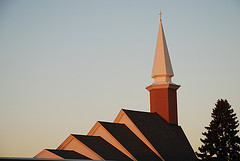If You Had 7 Acres, What Would You Do?
Could you and would you use it for God’s glory?
 Before you try to answer this question, we do know that that some of you live in a house where you have considerably less land than 7 acres (and some more), some of you are farmers and some of you are tried-and-true “urban dwellers” or “dorm denizens” with no land at all.
Before you try to answer this question, we do know that that some of you live in a house where you have considerably less land than 7 acres (and some more), some of you are farmers and some of you are tried-and-true “urban dwellers” or “dorm denizens” with no land at all.
But, regardless of where you live, we know that many of you are part of a community that owns land and a building. That community is also known as your Church.
The Local Church — Critical In Caring For Creation
Sometime last year during our travels around the country, we started to brainstorm if there was a way that Care of Creation could encourage and instruct churches how to better use the resources (e.g. their land and their buildings) that God has blessed them with to care for God’s creation.
We knew that in Kenya and the USA, the local church should play a critical role in caring for creation. Based on this, we started tackling the problem of how the local church in the USA could demonstrate creation care to their community. As part of this brainstorming process we confirmed our belief that here in the USA, what we need to do with regards to caring for creation is vastly different (but no less critical) than what needs to be done in Kenya.
As we started to look into this question, we discovered that this is not a trivial problem. The very nature of the USA church building itself presents a challenge. It may have a large paved area for parking (challenges for controlling water run-off, erosion and pollution), it has large spaces (challenges for the amount of energy used for heating and cooling), and it most likely is landscaped with medium to high-maintenance, water intensive plants. In addition, it is heavily used for part of the week and almost empty for the remainder of the week.
The summary to all this thinking? There’s a huge opportunity here and a lot of work to be done.
After our travels, we did some research and even more brainstorming and then put all that we discovered into a program called 4C.
4C (which stands for Creation Care Certified Congregation) is a program that we are designing and starting to implement. Targeted at churches in the USA, our intention for 4C is that it will be considered as a follow-on or an extension to the “Our Father’s World” seminar presented by Care of Creation at churches and colleges around the USA and around the world.
The goal of 4C is simple — to provide information and education to churches so that they can better use their land and buildings to care for creation.
A Better Building
Given that a church’s building is one of it’s largest expenses, one question we wanted to answer early on is “When a church builds or remodels its building, can it find ways to lighten the building’s environmental footprint — especially when it comes to the amount of energy it uses?”
In looking at this question, we knew that there are ways (such as LEED) that have been successfully used in recent years to build many energy-wise buildings. What we kept hearing was that most churches understand the benefits of less energy and would want a LEED certified building however, in most cases, they can’t afford the fees associated with a LEED certification.
Our solution to this issue was to develop a partnership with a local architect and builder (who both have extensive LEED experience) to adopt and document a set of church building guidelines and methods. These methods can be used to build the type of facility that makes sense for a church while providing the equivalent energy-efficiency that LEED certification would provide. All this at a cost that is significantly less than LEED certification.
We have already uncovered a number of opportunities to put these recommendation into practice with congregations that are embarking on extensive renovation projects. What is great about these opportunities is that these congregations are excited to be able to do something practical to care for creation and that these congregations are realizing that every dollar they get back from this effort is a dollar that they can re-allocate to missions and outreach.
Better Land Use
Buildings, we discovered, were only one part of the opportunity. Another part was the land that the church owned and the landscaping on that land.
Most of the churches we visited were beautiful. They were nicely landscaped with green grass, flowers and trees. All peaceful, beautiful ways to use land to glorify God. We also saw some other very wise and unique ways that churches were using their land as outreach to the community. For example, some of the churches we saw had set aside a part of their land for use as community garden. Plots in this garden were loaned to people who either had no land of their own or would benefit from the fresh fruit and produce that could be grown on the plots. We also saw churches who had incorporated rain gardens as part of water conservation activities.
Inspired by these efforts, we are gathering the experiences and knowledge of these churches so that we can help other churches be stewards of their land. Part of our vision for 4C is that along with our seminars, we can work with a church to plan, plant and launch an outreach community garden, to gently re-landscape while incorporating rain gardens and native plants and to help them plan how to incorporate paving options that return water to the aquifer instead of creating erosion-causing runoff. All good uses of God’s resources that love others and demonstrate creation care!
And More Intelligent Activities
We also were surprised (and pleased) that many of the churches we have been in contact with already have a group of “environmentally energized” individuals. These are people in the church who have, in their own congregation, taken action on creation care by encouraging others in the church and the church leadership to do the same.
We think that Care of Creation and the 4C program can be a place where these “green teams” can share and learn things like how to hold a “pot luck” or “covered dish” supper with alternatives to paper plates, styrofoam and plastic, or, how to launch an effective recycling program, even how to conserve resources that the church uses as part of its day to day activities.
As part of putting creation care into practice, we are also planning and hoping to coach youth leaders as well as adult teachers about how to incorporate creation care focused activities into short-term missions and local outreach programs. (For example, how about combining creation care and neighbor care into a youth-group activity like watershed maintenance?)
More Information
C4 is still in it’s infancy. We have a lot to learn but the focus for C4 is clear — it’s all about mobilizing the church to do what the word says about caring for creation.
There is some additional information about 4C on our website. and if you have comments or ideas, please drop us a line here at Care of Creation.
And finally, if you are an architect or a builder/developer who wants to work with us on a 4C project, please drop me a note at fred -[at]- careofcreation.org or call Care of Creation at 608.233.7048.
For the entire Care of Creation Staff, both in the USA and Kenya,
Fredric Gluck


